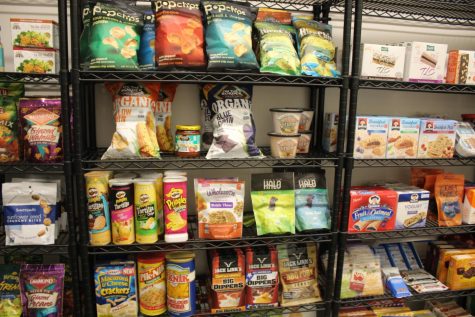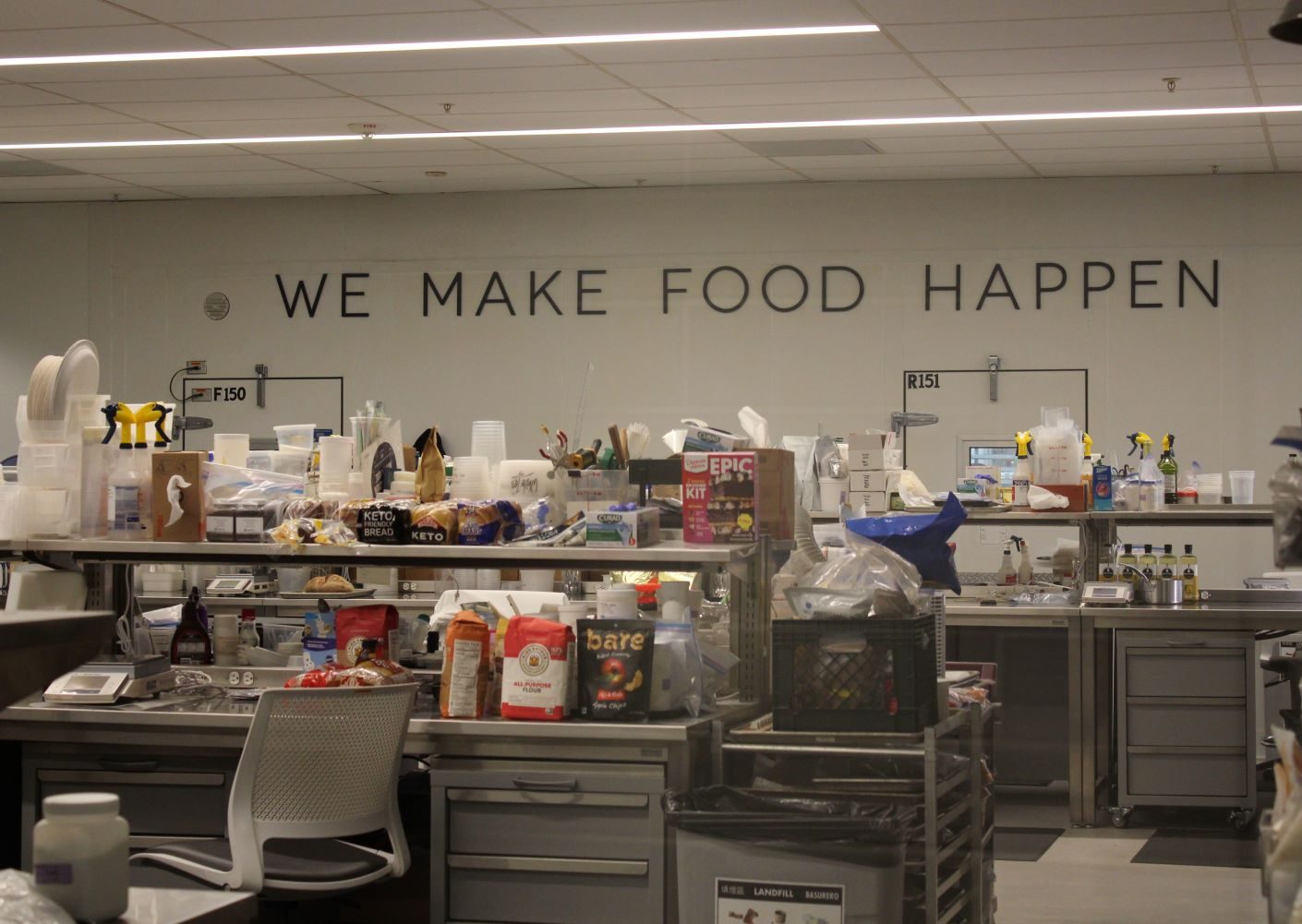
Creating fruitful impacts on sustainable nutrition
November 9, 2022
Naturally healthy. Low sugar. Sustainably sourced. Eco-friendly packaging. These considerations have become increasingly important to consumers when they make food decisions.
Seventy-six percent of shoppers put a lot or some effort into selecting nutritious and healthy food options, according to the 2022 Power of Health and Well-being in the Food Industry report. A plethora of high-quality food options are now available; the production of innovative food fulfills a customer’s dietary needs while simultaneously protecting the environment.
Recognizing these consumer demands, the food industry, including food research and development companies, grocers, and food services, are working hard to provide consumers with nutritious, sustainable food. New products that satisfy these requirements are created in the lab, then distributed to grocery stores, and end up in the hands of millions worldwide.
At the lab
Food research and development happens in the lab. Mattson is a food company focused on developing innovative products for the food industry. Their company focuses on changing the world of food through engagement with the industry and “inventing the future of food one product at a time.”
Creating new food products to sell to consumers is not an easy process. It requires a lot of brainstorming, prototyping, testing, and finalizing to ensure it is ready to be sold to consumers. Mattson helps consumer packaged goods manufacturers, food service operators, and suppliers formulate products and prepare them for consumer purchase.
Brenda Fong, a principal food scientist at Mattson, details how an idea is turned into a product sold on shelves.
“It starts with consumer insights which can be qualitative or quantitative. We conduct home-use tasks and online questionnaires to get feedback for the client, and then we incorporate ideas with an occasional ideation session. After that, concepts are created and identified. We go into the lab and start prototypes and development. We support our clients through any further in-market, incubation shelf life studies and ensure the product is ready for commercialization,” Fong said.
The food research and development approach at Mattson centers around the consideration of nutrition and sustainability.
“It is our responsibility to be on top of cutting-edge trends or different available ingredients. We do a lot of plant-based development, which utilizes upcycled or regenerative ingredients that are coming to light. We like to inform our clients of all these options so that they can have the knowledge to make more sustainable choices for their decision-making process,” said Maddison Gurrola, a food scientist at Mattson.
Mattson has created a variety of products, such as vegan and plant-based protein beverages, powders, burgers, gluten-free cookies, and snacks that cater to those with different food preferences. However, developing a more comprehensive range of healthy and eco-friendly options for those with dietary restrictions comes with a cost.
“Many of the products we develop are natural channel products, which have dietary restrictions as part of their point of differentiation. These have a higher price point because the formulations can be customized to have those additional requirements with specialized ingredients,” said Lisa Pitka, a principal food scientist at Mattson.
A McKinsey report states, “Consumers expect to spend more money on food with

specific attributes, such as high protein and natural ingredients.” Although these may have a high price point, cutting-edge food products give Americans more choices on what they put in their bodies to affect their health and the environment positively.
“I think the products we create and develop allow for consumer awareness on environmental issues,” Fong said. “We’re trying to incorporate sustainability in our food products so that consumers can be a participant in that when they choose the foods that they want to eat and pay more attention to what they put in their body.”
On the shelves
According to a United States Department of Agriculture (USDA) National Household Food Acquisition and Purchase Survey, 87% of households acquire food from large grocery stores in a typical week and purchase almost two-thirds of their calories from supermarkets.
The food grocery stores provide consumers plays a significant role in the nutrition we receive in our daily diets and affects the quality of the products purchased. These products come from vendors that sell their items to grocery stores to stock their shelves.
“We are constantly negotiating with vendors to offer lower prices on high-quality and healthy items. We also ensure the quality of our food by conducting temperature checks, checking expiration dates, and doing a product inspection before we put them on shelves,” said Bill Go, store manager of Lunardi’s market located in Belmont, Calif.
The regulation of food available to shoppers guarantees each product is up to standards. The United States Food and Drug Administration has over 3,000 agencies responsible for regulating the retail food and food service industries. They inspect over 1 million food establishments that feed people around the country, including grocery stores, restaurants, cafeterias, and more.
A large sector of customers is those with dietary preferences or restrictions. According to a study by the Vegetarian Times, 7.3 million Americans are vegetarians, and another 22.8 million follow a vegetarian-inclined diet. These people may have a challenging time acquiring the food that fits their preferences, which is why grocery stores continue to invest in new products to sell in stores.
“Vendors who study consumer preferences and needs always suggest new products for us to carry they think will benefit customers,” Go said.
Once a vendor proposes a new product to sell in stores, grocers decide whether to approve it or not. If approved, it will soon become available for shoppers to purchase. The abundance of new, innovative products keeps the food at grocery stores exciting and allows consumers a variety of choices.
Grocery stores have also been trying to shift to more environmentally friendly practices regarding food and store regulations. Lunardi’s has been one of the first in the industry to implement solar power as its primary lighting source. According to Lunardi’s website, the Burlingame store uses a direct current system to fuel its fluorescent lighting system. The Walnut Creek store has an inverter that converts energy into alternating current.
Go explains another way they are protecting the environment, specifically food waste.
“Along with using solar power as our main light source, we also partnered with local churches and food banks to donate our foods that are not up to our standards. This eliminates overall food waste and gives food to those in need,” Go said.
The USDA states that food waste is estimated at 30% to 40% of the food supply in the United States. Small efforts such as donating food that would otherwise be wasted all contribute to helping the environment.
In our hands
Every day at lunch, millions of students nationwide line up for meals provided by the school. In the school year from 2021 to 2022, the National School Lunch Program program provided 2.2 billion meals, 98.9% of which were served free or at a reduced price, as reported by the USDA.
Most cafeterias in America, including the Sequoia Union High School District (SUHSD), serve a variety of foods covering all five food groups: fruits, vegetables, grains, protein, and dairy.
Sandra Jonaidi, the director of food services for the SUHSD, describes how funding from the USDA and the state of California to feed students is used to source nutritious meals.
“The first pot we allocate money towards is called the Department of Defense. This helps us buy fresh seasonal produce throughout the year. The second pot is called the brown box, where items such as broccoli, frozen fruit cups, hamburgers, turkey roasts, and ground beef fall into this category. The third pot is for processed foods. We buy these at a significantly discounted rate because of the commodity food contribution,” Jonaidi said.
The three pots include all the nutrition a student would need to last throughout the school day. However, many choose not to consume healthier meal offerings.
Carlmont junior Hana Beydoun shares her perspective on how lunch choices result in students not gaining sufficient nutrition.
“I think the popular items are pizza, sandwiches, and then at the bottom of the ladder, it’s salads. The salads are so unappetizing that it’s just not a good option. People are not getting what they need in their daily diets from school lunches,” Beydoun said.
Along with improving the food quality, the SUHSD has to consider the sustainability of the food purchased. According to Jonaidi, they buy locally-grown produce with no chemicals. This creates the issue of only being able to buy items that are in season, so the district is thinking of ways to solve this problem.
“At the moment, I am very interested in trying to get a container farm so that we can grow our own salad items year-round and no longer use commercially purchased salad. Hopefully, we can get that rolling before the end of this school year,” Jonaidi said.
The distribution of free lunches also leads to food waste. The California Department of Education states that milk is required in all Child Nutrition Programs, and students must take a carton. It also declares that the cafeteria must provide students with free fresh fruit or vegetables to teach them about good nutrition. Yet the good intentions of these policies are backfiring.
Be aware of what food you put in your mouth, school meals are actually always healthy, and our menus are created to optimize a healthy lifestyle.
— Sandra Jonaidi
“The cafeteria forces kids to take milk and fruit they don’t even eat, so it ends up in garbage cans. Compost bins are so far apart and sparse that people just throw them away,” Beydoun said.
Schools are conscious of food waste that piles up every lunch. Share bins are being placed on campuses to collect untouched food and hopefully reduce the amount of food thrown away.
“I would encourage every school to see what they can do with the food left in the share bin because it can be donated,” Jonaidi said. “When I visit schools and see so much food in trash cans, it’s upsetting.”
More compost bins are scattered around the campus, but this could encourage students to toss their food instead of putting it in the share bins.
Jonaidi urges students to send suggestions to help schools improve their menus.
“Be aware of what food you put in your mouth, school meals are actually always healthy, and our menus are created to optimize a healthy lifestyle. You can help us evolve by sending in recommendations or recipes. We will do what we can to add them while keeping them within the federal guidelines so we know they’re healthy,” Jonaidi said.
The future of food
The food industry is constantly evolving. Food is becoming more sustainable, and consumers are increasingly turning to plant-based food, which is more environmentally friendly. According to a Bloomberg Study, plant-based diets have increased by 300% for Americans in the last 15 years.
Increased health and environmental consciousness drive consumer decisions, meaning food production and manufacturing companies must adapt accordingly. There is not one answer to where the future of food holds. It is striving to balance conventional food products with new technology and developments.
“Being in food innovations means exploring the possibilities of food and learning from old and applying to new with it but in novel ways,” Pitka said. “It is hard to say what the future food will hold, but so much change has happened in the past 10 years that it’s exciting to see what’s on the horizon.”


